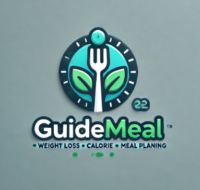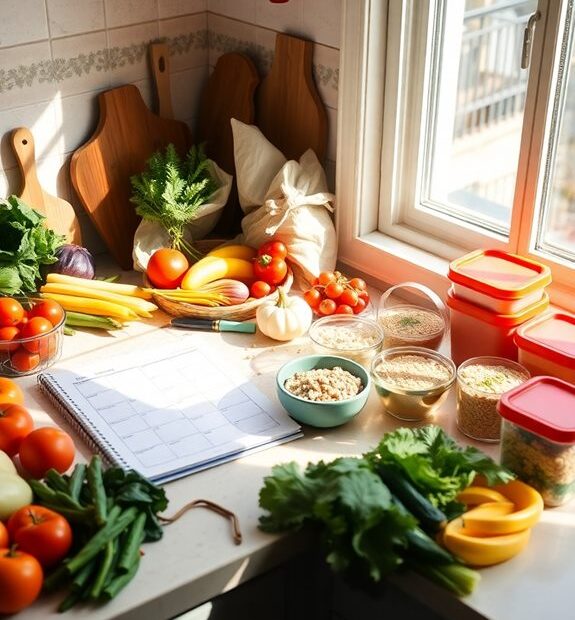Want to make meal planning easy and enjoyable? Start by understanding your dietary needs—track what you eat and listen to your body. Then, create a flexible template for meals, like having Taco Tuesday or Meatless Monday, which adds fun! Finally, don't forget to incorporate seasonal ingredients. They taste better, cost less, and support local farmers. Think about this: wouldn't you enjoy fresh veggies that are in season? These three tips can help you feel better and save time. There's so much more to explore about successful meal planning that can transform how you eat! 🍽️✨
Key Takeaways
- Assess individual dietary needs based on age, activity level, and health goals to create a personalized meal plan.
- Incorporate seasonal ingredients for enhanced flavor, nutrition, and cost-effectiveness while supporting local agriculture.
- Establish a flexible meal template that allows for themed days and easy swaps based on your schedule.
- Plan for leftovers by cooking extra portions, which can be creatively repurposed into new meals, saving time and reducing waste.
- Regularly monitor and revise your meal plan to reflect changes in energy levels, cravings, and personal goals for continuous improvement.
Understand Your Dietary Needs
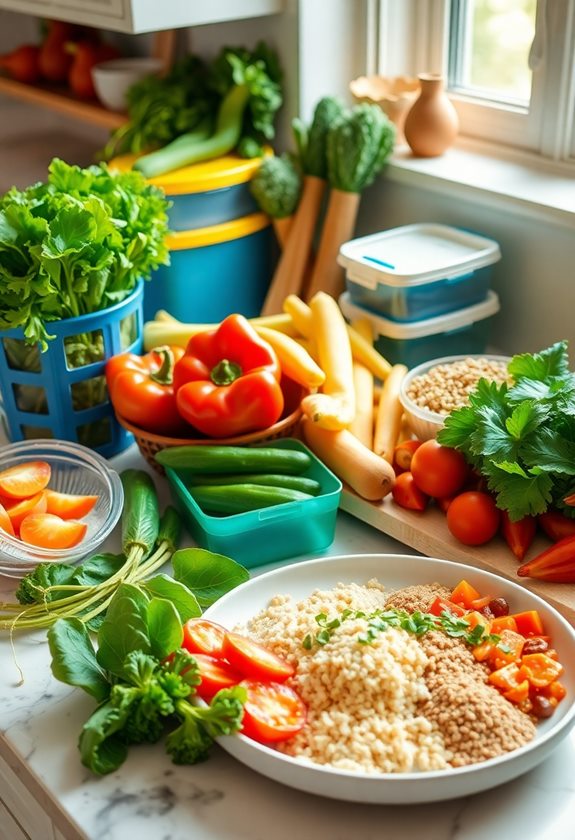
Understanding your dietary needs is essential for successful meal planning. 🥗 Have you ever wondered why some diets work for others but not for you? Everyone's body is unique, and your dietary needs can depend on age, activity level, and health goals. Take a moment to think about your own lifestyle. Utilizing tools like a Wellness Planner & Fitness Log can help you better track your nutrition and habits.
Do you need more protein for muscle building, or are you looking to cut back on carbs? Maybe you have allergies or specific dietary restrictions. Knowing these details helps you make better choices.
Start by keeping a food diary for a week. Write down what you eat, how it makes you feel, and any cravings that pop up. This will give you valuable insight into your habits. You might discover that you feel better when you eat more whole foods or when you stay hydrated.
Don't forget to consult a healthcare professional if you're unsure about your needs. They can provide guidance tailored to you. Remember, meal planning isn't just about what you eat; it's about how it fits into your life. Stay aware of your body's signals, and you'll make choices that support your health!
Create a Flexible Template
Once you've identified your dietary needs, it's time to create a flexible meal planning template that works for you. A good template helps you organize meals while still allowing room for change. Start with a basic structure: breakfast, lunch, dinner, and snacks. Does that sound simple? It is! Incorporating durable meal prep containers can also streamline your planning process, ensuring that your meals stay fresh and organized.
Next, your template should include options for different days. You might plan a meatless Monday or taco Tuesday. This keeps things exciting! You can write down a few go-to recipes for each category. For example, if you love pasta, list two or three pasta dishes that fit your needs.
Remember, flexibility is key. You can swap meals around based on your week. If you're busy on a Thursday, maybe move a quick recipe to that day. You could even pencil in a "leftovers" night to clear out your fridge.
Lastly, don't be afraid to change your template as you go. What worked last month might not fit this month. Keep it fun and fresh! With a flexible template, you'll find meal planning becomes easier and more enjoyable. Ready to get started? Let's make meal planning a breeze!
Incorporate Seasonal Ingredients
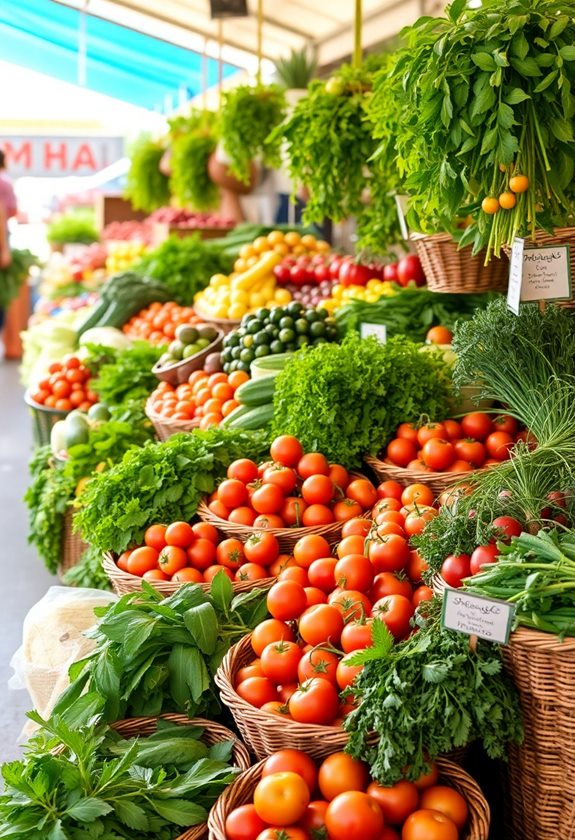
Incorporating seasonal ingredients into your meal plan not only boosts flavor but also enhances nutrition and sustainability. Have you ever tasted a ripe summer tomato or a crisp fall apple? There's a world of difference when you use ingredients at their peak! By selecting seasonal produce, you can also enjoy the benefits of meal variety and nutritional balance, ensuring a diverse and satisfying diet.
When you choose seasonal produce, you're likely getting items that are fresher and packed with nutrients. This means more vitamins for you and your family! Plus, seasonal ingredients often cost less since they're abundant. Who doesn't want to save a little money while eating better?
To make it easy, check what's in season in your area. You can find lists online or at local farmers' markets. For example, in spring, you might enjoy asparagus and strawberries, while winter brings hearty root vegetables like carrots and potatoes.
Try planning your meals around these seasonal foods. Imagine a colorful salad with fresh greens and juicy peaches in summer or a cozy soup with squash in winter. By doing this, you'll not only enjoy delicious meals but also support local farmers and reduce environmental impact. Isn't that a win-win?
Plan for Leftovers
Planning meals with seasonal ingredients not only enhances your dishes but also sets the stage for effective meal prep. One smart strategy is to plan for leftovers. Why waste food when you can enjoy it twice?
Start by cooking a bit more than you need for dinner. For example, if you roast a chicken, save the extra for sandwiches or salads the next day. This not only saves time but also cuts down on cooking stress. Do you ever find yourself too tired to cook again? Leftovers come to the rescue!
You can also repurpose ingredients. If you make a big pot of chili, use the leftovers in a taco night or mix it into a casserole. It's fun to get creative!
Don't forget to store your leftovers properly. Use airtight containers to keep them fresh, and label them with dates. This way, you'll know what's good to eat and when.
Planning for leftovers means less time in the kitchen and more time enjoying your meals. So, next time you're cooking, think about how you can turn one meal into two. 🌟
Adjust Portion Sizes
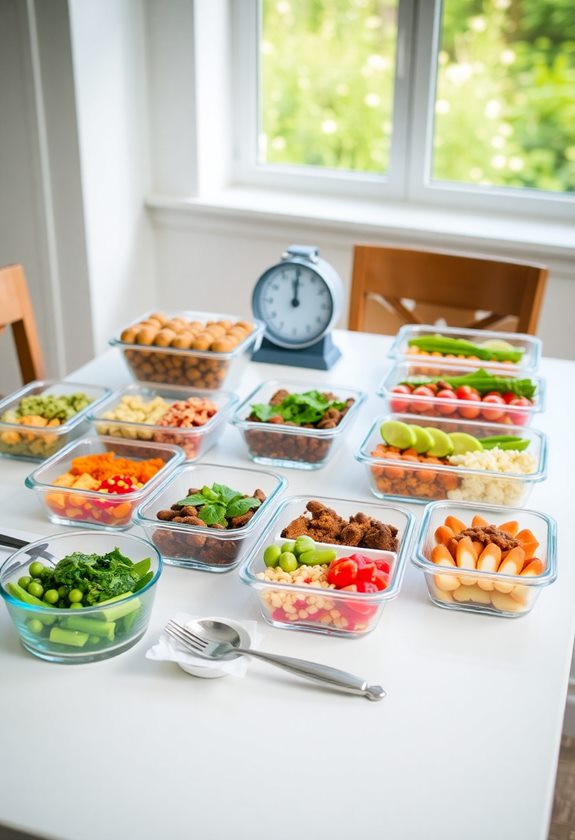
Adjusting portion sizes can make a significant difference in your meal planning. Have you ever noticed how easy it is to overeat? By being mindful of your portions, you can enjoy your meals without feeling stuffed. Start by using smaller plates. This simple trick can make your servings look bigger, helping you feel satisfied with less.
Next, think about your goals. Are you trying to lose weight or maintain it? Adjusting portion sizes can help you align with those goals. For example, if you're making pasta, try measuring out one cup instead of just pouring it onto your plate. You'll be surprised at how much that can help!
Also, consider your activity level. If you've had a busy day, you might need a larger portion for dinner. But on a less active day, cut back a bit. It's all about listening to your body.
Lastly, don't forget to add plenty of veggies! They're low in calories and high in nutrients. By adjusting your portion sizes, you'll create a balanced meal that feels good, tastes great, and supports your goals. 🍽️
Monitor and Revise Your Plan
After you've fine-tuned your portion sizes, it's time to keep an eye on your meal plan's effectiveness. How do you know if it's working? Monitoring your progress is key. Check in with yourself weekly. Are you feeling energized? Are your clothes fitting better? These questions can guide you!
To help visualize your journey, consider tracking your meals and feelings like this:
| Day | Meals Prepared | Emotions/Thoughts |
|---|---|---|
| Monday | Chicken Salad | Energized and happy! |
| Wednesday | Veggie Stir-Fry | A bit tired, need more carbs! |
| Friday | Pasta Night | Loved it, but felt too full. |
Adjust based on what you see. If something doesn't feel right, don't hesitate to revise! Maybe you need more snacks or less of a certain food. It's all about finding what works best for you. Remember, meal planning is a journey, not a race. So, keep experimenting until you find your groove! 🌟
Frequently Asked Questions
How Do I Handle Food Allergies in Meal Planning?
You'd think food allergies would make meal planning simpler, right? Instead, they add a twist! Start by identifying allergens, then craft delicious meals around safe ingredients, ensuring everyone enjoys their plates without worry.
What Are Some Quick Meal Prep Ideas?
You can simplify your meal prep by batch-cooking grains, roasting a variety of vegetables, and preparing proteins like chicken or tofu in advance. These ideas save time and keep your meals diverse and delicious throughout the week.
How Do I Track My Food Expenses?
To track your food expenses, start by keeping a dedicated notebook or app. Record every purchase, categorize them, and review weekly. This'll help you identify spending patterns and adjust your budget effectively.
Can I Meal Plan for Special Occasions?
Absolutely, you can meal plan for special occasions! Just consider your guests' preferences, choose a theme, and create a menu that balances flavors and textures. It'll make your event enjoyable and stress-free. Enjoy the celebration!
What Are the Best Apps for Meal Planning?
In today's tech-savvy world, you can't go wrong with apps like Mealime, Paprika, and Plan to Eat. They simplify planning, offer recipes, and help you create shopping lists. You'll love how easy it gets!
